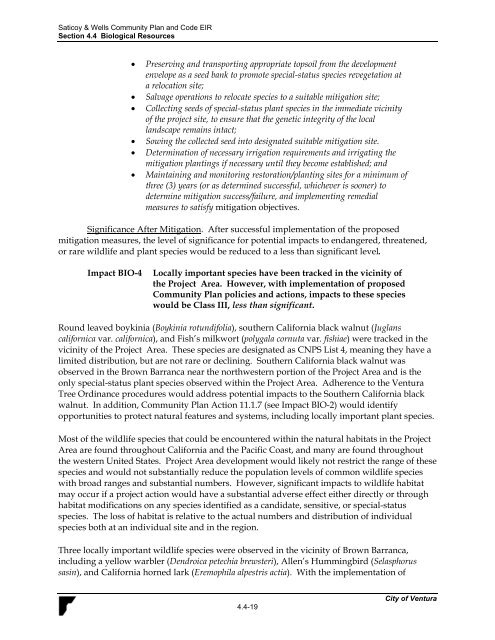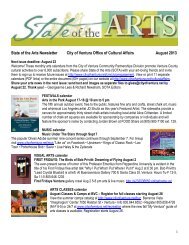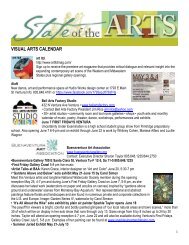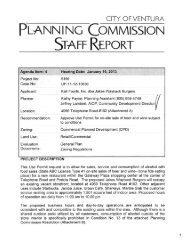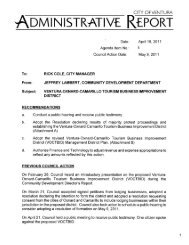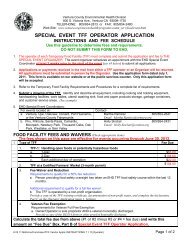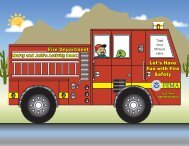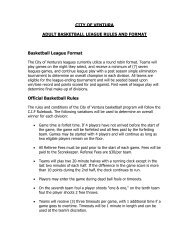Saticoy & Wells Community Plan & Development ... - City Of Ventura
Saticoy & Wells Community Plan & Development ... - City Of Ventura
Saticoy & Wells Community Plan & Development ... - City Of Ventura
You also want an ePaper? Increase the reach of your titles
YUMPU automatically turns print PDFs into web optimized ePapers that Google loves.
<strong>Saticoy</strong> & <strong>Wells</strong> <strong>Community</strong> <strong>Plan</strong> and Code EIRSection 4.4 Biological Resources• Preserving and transporting appropriate topsoil from the developmentenvelope as a seed bank to promote special-status species revegetation ata relocation site;• Salvage operations to relocate species to a suitable mitigation site;• Collecting seeds of special-status plant species in the immediate vicinityof the project site, to ensure that the genetic integrity of the locallandscape remains intact;• Sowing the collected seed into designated suitable mitigation site.• Determination of necessary irrigation requirements and irrigating themitigation plantings if necessary until they become established; and• Maintaining and monitoring restoration/planting sites for a minimum ofthree (3) years (or as determined successful, whichever is sooner) todetermine mitigation success/failure, and implementing remedialmeasures to satisfy mitigation objectives.Significance After Mitigation. After successful implementation of the proposedmitigation measures, the level of significance for potential impacts to endangered, threatened,or rare wildlife and plant species would be reduced to a less than significant level.Impact BIO-4Locally important species have been tracked in the vicinity ofthe Project Area. However, with implementation of proposed<strong>Community</strong> <strong>Plan</strong> policies and actions, impacts to these specieswould be Class III, less than significant.Round leaved boykinia (Boykinia rotundifolia), southern California black walnut (Juglanscalifornica var. californica), and Fish’s milkwort (polygala cornuta var. fishiae) were tracked in thevicinity of the Project Area. These species are designated as CNPS List 4, meaning they have alimited distribution, but are not rare or declining. Southern California black walnut wasobserved in the Brown Barranca near the northwestern portion of the Project Area and is theonly special-status plant species observed within the Project Area. Adherence to the <strong>Ventura</strong>Tree Ordinance procedures would address potential impacts to the Southern California blackwalnut. In addition, <strong>Community</strong> <strong>Plan</strong> Action 11.1.7 (see Impact BIO-2) would identifyopportunities to protect natural features and systems, including locally important plant species.Most of the wildlife species that could be encountered within the natural habitats in the ProjectArea are found throughout California and the Pacific Coast, and many are found throughoutthe western United States. Project Area development would likely not restrict the range of thesespecies and would not substantially reduce the population levels of common wildlife specieswith broad ranges and substantial numbers. However, significant impacts to wildlife habitatmay occur if a project action would have a substantial adverse effect either directly or throughhabitat modifications on any species identified as a candidate, sensitive, or special-statusspecies. The loss of habitat is relative to the actual numbers and distribution of individualspecies both at an individual site and in the region.Three locally important wildlife species were observed in the vicinity of Brown Barranca,including a yellow warbler (Dendroica petechia brewsteri), Allen’s Hummingbird (Selasphorussasin), and California horned lark (Eremophila alpestris actia). With the implementation of4.4-19<strong>City</strong> of <strong>Ventura</strong>


